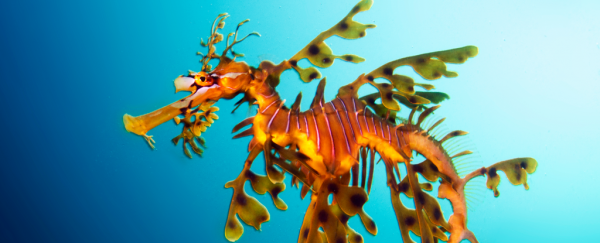Spotting a wispy sea dragon, floating amongst the seaweed, embellished with leaf-like adornments ruffling in swaying ocean currents, is truly a sight to behold.
But there is more to sea dragons than meets the diver's eye. Bedazzled as they may be, sea dragons are also missing teeth, lacking ribs, and their spines are curved and kinked.
Now, scientists have found genetic clues that might explain why sea dragons appear so strikingly distinctive – not only are their genomes packed with repetitive chunks of DNA that drive evolution, but they are also missing a group of genes that give rise to teeth, nerves, and facial features in other animals.
Exploring the genomes of sea dragon genomes has "lifted a veil on the evolution of sea dragon-specific traits" and "revealed intriguing evolutionary facets of this unusual vertebrate family, the Syngnathidae, as a whole," the team behind the study writes in a new paper.
Sea dragons belong to the same family as pipefish and sea horses, the Syngnathidae, which are renowned for having evolved male pregnancy.
"This group is just cool for a number of different reasons," says evolutionary genomics researcher Clayton Small from the University of Oregon, who co-led the study alongside fellow researcher Susan Bassham.
"But sea dragons are oddballs in a group of already oddball fish."
To find out why, Small, Bassham, and the team sequenced the genomes of two sea dragon species: the leafy sea dragon and the weedy or common sea dragon, both of which are found in cool waters off the southernmost coasts of Australia.
Drifting along with their leaf-like fronds helping to camouflage them in kelp-covered rocky reefs, these slender fish can be hard to spot.
So elusive, in fact, that the third (of only three) species of sea dragon, the rare ruby sea dragon (which was not sequenced in this study) was only glimpsed in the wild for the first time in 2017.
All three species of sea dragons are revered for their colorful, fantastical body forms and long, tubular crustacean-sucking snouts, but the ruby sea dragon appears to have lost the leafy appendages exhibited by the others, with evolution doing away with the extravagant frills.
Scientists reckon sea dragons evolved their extravagant features fairly quickly, in the past 50 million years or so, since they and sea horses branched off to form a new family.
What's less clear is how they came to look so distinctive, however. So for this study, the University of Oregon researchers teamed up with scientists from the Birch Aquarium at Scripps Institution of Oceanography, and the Tennessee Aquarium, to analyze what samples they had from sea dragons raised in captivity.
It turns out that sea dragons, compared to their closest relatives, pipefish and seahorses, have in their genetic code a surprisingly large number of repetitive DNA sequences called transposons, otherwise known as 'jumping genes'.
So mobile are transposons, hopping around in the genome, that they can create rapid genetic changes – which might explain why sea dragons evolved so quickly.
Compared to two distant relatives, zebrafish and sticklebacks, the genomes of leafy and weedy sea dragons are missing a chunk of genes that play indispensable roles in other vertebrates, containing instructions on how to form facial structures, teeth, limbs, and even parts of the central nervous system.
While the researchers were tempted to speculate that the loss of these genes might explain how sea dragons developed elongated facial features and fabulous frills, more research will be needed to probe the evolutionary history of sea dragons and their relatives.
But the researchers were not done yet, also imaging a foot-long adult male weedy sea dragon specimen with high-resolution X-ray microscope scans, which revealed that the ornamental appendages likely evolved from spines.
"We could see that the support structures for the leafy paddles appeared to be elaborations of spines [with fleshy appendages] added to the ends," says Bassham.
The team also noticed that these bony supports differed from the hardened, ossified bones found in the fins of most bony fish, and instead appear to be stiffened by a core of collagenous tissue – adding to the story of how the sea dragon's unique body structures came to be.
However sea dragons evolved, the results are glorious, glamorous even. For all we know, sea dragons might yet have a few more secrets tucked away in their genome, which may be uncovered with further genetic comparisons.
The study was published in PNAS.
